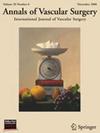Progressive Protocols for Pediatric Acute Lower Extremity Ischemia Postcatheterization Pediatric Lower Extremity Ischemia Protocol Postcatheterization
IF 1.4
4区 医学
Q3 PERIPHERAL VASCULAR DISEASE
引用次数: 0
Abstract
Background
Pediatric acute lower extremity ischemia postcatheterization (PALIC) represents a significant clinical challenge. Effective management protocols that minimize aggressive interventions and complications are essential for improving patient outcomes. This investigation assesses the effectiveness of the FAST protocol (Fasudil infusion combined with Anticoagulation based on oxygen Saturation monitoring backup with Thrombolytic) series in treating pediatric acute lower extremity ischemia after catheterization (PALIC), with a particular emphasis on minimizing aggressive interventions and complications.
Methods
A retrospective study of 1,380 pediatric catheterization cases from January 2009 to December 2022 was conducted. The research encompassed 3 stages: before FAST implementation (stage 1), during initial FAST adoption (stage 2), and subsequent FAST+ upgrade (stage 3).
Results
Acute lower extremity ischemia (ALI) was observed in 7.1% (98/1,380) of pediatric cases postcatheterization. The PALIC detection rates in stages 2 and 3 were 4.2% and 12.1%, respectively, showing a statistically significant reduction in aggressive interventions from 100% to 0% and complications from 100% to 1.2% in later stages (P < 0.05).
Conclusion
The safety and effectiveness of both the FAST and FAST+ protocols in managing PALIC have been demonstrated. The enhanced FAST+ protocol notably improve early detection, thereby augmenting the effectiveness of treatment.
小儿急性下肢缺血置管后的渐进式方案
背景:小儿急性下肢缺血置管后(PALIC)是一项重大的临床挑战。有效的管理方案,尽量减少积极的干预和并发症是改善患者的结果至关重要。本研究评估FAST方案(法舒地尔输注联合基于氧饱和度监测和溶栓的抗凝)系列治疗小儿导管置管后急性下肢缺血(PALIC)的有效性,特别强调最小化积极干预和并发症。方法回顾性分析2009年1月至2022年12月1380例小儿置管病例。研究包括3个阶段:FAST实施前(第一阶段),FAST最初采用期间(第二阶段),以及随后的FAST+升级(第三阶段)。结果7.1%(98/ 1380)儿童置管后出现急性下肢缺血(ALI)。PALIC在第2期和第3期的检出率分别为4.2%和12.1%,表明晚期积极干预从100%减少到0%,并发症从100%减少到1.2% (P <;0.05)。结论FAST和FAST+治疗PALIC的安全性和有效性已得到证实。增强的FAST+方案显著改善了早期发现,从而提高了治疗的有效性。
本文章由计算机程序翻译,如有差异,请以英文原文为准。
求助全文
约1分钟内获得全文
求助全文
来源期刊
CiteScore
3.00
自引率
13.30%
发文量
603
审稿时长
50 days
期刊介绍:
Annals of Vascular Surgery, published eight times a year, invites original manuscripts reporting clinical and experimental work in vascular surgery for peer review. Articles may be submitted for the following sections of the journal:
Clinical Research (reports of clinical series, new drug or medical device trials)
Basic Science Research (new investigations, experimental work)
Case Reports (reports on a limited series of patients)
General Reviews (scholarly review of the existing literature on a relevant topic)
Developments in Endovascular and Endoscopic Surgery
Selected Techniques (technical maneuvers)
Historical Notes (interesting vignettes from the early days of vascular surgery)
Editorials/Correspondence

 求助内容:
求助内容: 应助结果提醒方式:
应助结果提醒方式:


